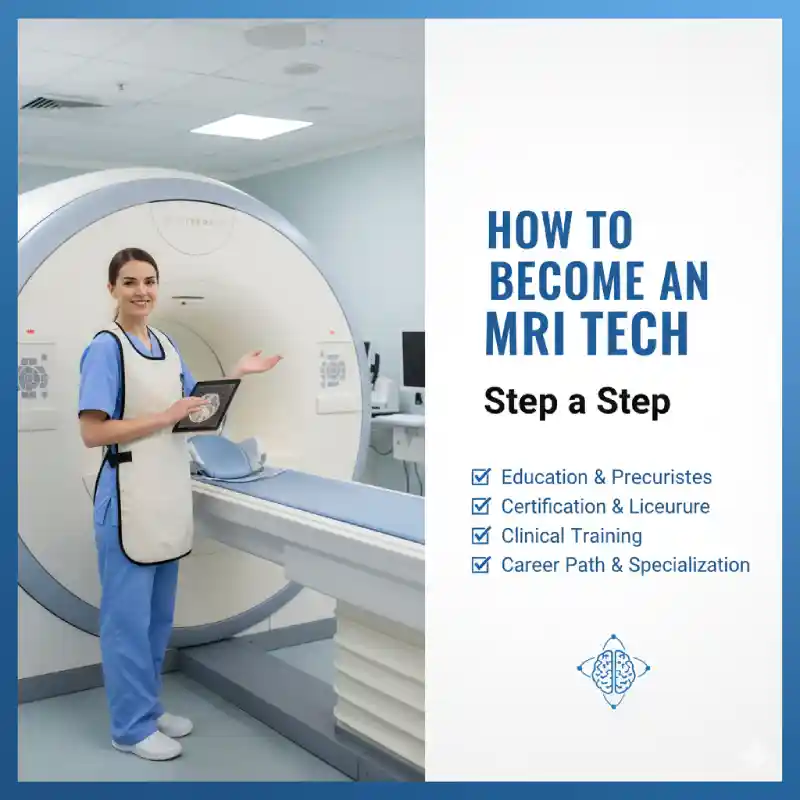Let’s be honest. Most people don’t really think about who runs those big, loud MRI machines at hospitals. You just go in and lie down and pray the scan ends soon, right? But there’s always a professional behind the machine. That person is an MRI technologist (or MRI tech).
Now here’s the thing. MRI techs are in high demand. Hospitals, clinics, and diagnostic centers all need them. Why? Because MRI scans are one of the most common ways doctors figure out what’s really going on inside your body, brain , spine joints and more.
So if you’re wondering, “How do I actually become an MRI tech?” then you’re in the right place. This article explains the steps, skills, education, salary, and even the good and not-so-good sides of this career.
What Does an MRI Tech Actually Do?
Okay, before we talk about how to become one, let’s get clear on what MRI techs actually do every day.
- They operate MRI machines.
- They make patients feel comfortable (because lying still in a tube isn’t fun).
- They get images for doctors to diagnose conditions.
- They follow safety rules since MRI machines use strong magnets.

So it’s not just technical work. It’s also about people skills. You could be helping a little kid one day and an older patient the next.
Why Consider This Career?
Three big reasons:
1. Good pay. The average is about $80,000 per year in the U.S. Some make more, depending on the state.
2. Job security. Healthcare is always needed. MRIs aren’t going anywhere.
3. Meaningful work. You’re directly helping patients.
Check this official page for salary info: [BLS Radiologic and MRI Technologists]
(https://www.bls.gov/ooh/healthcare/radiologic-technologists.htm).
Steps to Become an MRI Tech
Alright, let’s break it down step by step.
1. Finish High School or GED
Sounds basic, but it’s step one. Focus on:
- Biology
- Physics
- Math
These subjects actually matter later when you’re learning about the human body and how imaging works.
2. Choose Your Education Path
You can’t just walk into a hospital and say, “Hey, I want to be an MRI tech.” You need formal training. Two main routes:
1. Associate Degree (2 years)
- Covers radiologic technology.
- Includes basics like X-rays, CT scans, and some MRI.
2. Bachelor’s Degree (4 years)
- Longer but opens more career doors.
- Sometimes includes advanced imaging techniques.
For details, see [ARRT’s official education requirements]
(https://www.arrt.org/pages/earn-arrt-credentials/initial-requirements/primary-pathway).
3. Specialize in MRI
After your degree, you usually need extra MRI-specific training. Many colleges offer 1-year certificate programs that include:
- MRI physics
- Anatomy
- Safety training
- Clinical practice

This is where you get comfortable with the actual machines. You’ll practice with real patients under supervision.
–4. Get Certified and Licensed
Most hospitals won’t hire you without certification. The most recognized one is ARRT certification.
Steps:
1. Graduate from an accredited program.
2. Pass the ARRT exam.
3. Renew your certification with continuing education.
Some states also require a license. You can check here: [ARRT State Licensing Map]
(https://www.arrt.org/pages/state-requirements).
5. Build the Right Skills
MRI techs need more than technical training. You’ll need:
- Technical skills: Running machines, fixing small errors.
- Communication: Explaining to patients what’s going on.
- Compassion: Some patients are scared.
- Detail-oriented mindset: Images must be clear.
6. Apply for Jobs and Gain Experience
Once certified, you can apply for positions in:
- Hospitals
- Outpatient imaging centers
- Private clinics

With experience, you could become a lead MRI tech, a supervisor, or even a trainer for new students.
Salary: What Can You Expect?
Money matters. Let’s be real.
- Average pay: $80,000/year
- Top earners: Over $100,000/year (California, Massachusetts, Hawaii)
- Entry-level: Around $55,000–$60,000/year
Resource for more numbers: [Salary.com MRI Tech Pay Data]
(https://www.salary.com/research/salary/benchmark/mri-technologist-salary).
Pros and Cons
Pros
- Good income
- Job growth is strong
- Stable career field
- Helping people directly
Cons
- Training takes time
- Must renew certification
- Sometimes stressful (patients can panic in the MRI machine)
- Long hours on your feet
Tips for Success
- Shadow an MRI tech before choosing this career.
- Stay updated with new MRI technology.
- Network: Join groups like [American Society of Radiologic Technologists](https://www.asrt.org/).
- Choose location wisely — pay varies a lot by state.
FAQs
How long does it take to become an MRI tech?
Usually 2–4 years plus certification time.
Do MRI techs make good money?
Yes. On average, about $80k per year.
Can I become an MRI tech without a degree?
No, you need at least an associate degree and certification.
Is this career stressful?
Sometimes, yes, but many MRI techs say it’s rewarding too.
Conclusion
Becoming an MRI tech is not a one-day process. It takes education, certification, and practice. But once you’re there, you will have a career that pays well, stays in demand and makes a real difference in patients’ lives.
If you do not want to spend ten years in medical school but still want to be in healthcare this might be your path. It’s technically yes but also about empathy and communication.
So, if you’re asking“How do I become an MRI tech?” The answer is simple: Finish school → Get trained → Get certified → Start working → Keep learning.


